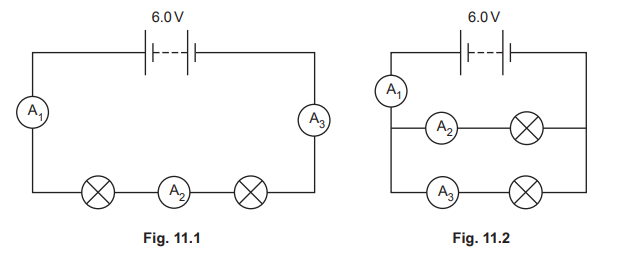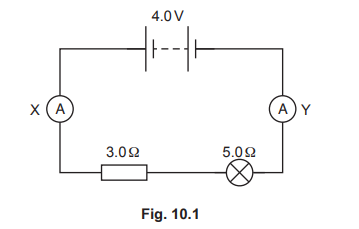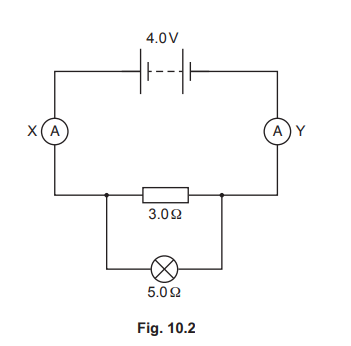Question
Fig. 11.1 shows lamps in series. Fig. 11.2 shows lamps in parallel.
The lamps are all identical 6.0 V lamps. In each circuit there are three ammeters \(A_1\), \(A_2\) and \(A_3\).

(a) (i) Compare the readings on ammeters \(A_1\), \(A_2\) and \(A_3\) in Fig. 11.1.
(ii) Compare the readings on ammeters \(A_1\), \(A_2\) and \(A_3\) in Fig. 11.2.
(iii) State two advantages of connecting the 6.0 V lamps in parallel with the 6.0 V battery,
compared with connecting the lamps in series with the battery.
1.
2.
(b) Each lamp has a resistance of 12 Ω.
(i) Determine the combined resistance of the two lamps connected in series.
resistance = ……………………………………………. Ω
(ii) Compare the resistance of one lamp with the combined resistance of the two lamps in
parallel.
Answer/Explanation
Answer:
(a)
(i) the ammeters all have the same reading
(ii) the reading on \(A_1\) is the biffest
(iii) lamps have normal brightness *in parallel) or brighter (than lamps in series)
If one lamp fails the other lamp is still lit
(b)
(i) 24 (Ω)
(ii) (resistance of one lamp/12 (Ω)) is more (than the combined resistance (or lamps in parallel)
Question
(a) Fig. 10.1 shows a lamp and a resistor connected in a circuit.

Determine the combined resistance of the 3.0 Ω resistor and the 5.0 Ω lamp.
combined resistance = ………………………………………………………………………… Ω [1]
The reading on ammeter X is 0.50 A. State the reading on ammeter Y.
reading on ammeter Y = ………………………………………………………………………….. A [1]
(b) In another circuit, the 3.0 Ω resistor and the 5.0 Ω lamp are connected in parallel, as shown in Fig. 10.2.

The lamp and resistor have changed from a series to a parallel combination.
State and explain the effect of this change on the current in ammeter X.
…………………………………………………………………………………………………………………………………
…………………………………………………………………………………………………………………………………
…………………………………………………………………………………………………………………………………
………………………………………………………………………………………………………………………………… [c]
(c) The current in a different lamp is 0.40 A when the potential difference (p.d.) across the lamp is 6.0 V.
Calculate the resistance of the lamp.
resistance of lamp = …………………………………………….. Ω [3] [Total: 8]
Answer/Explanation
Ans: (a)(i) (3.0 + 5.0 =) 8.0 (Ω)
(a)(ii) 0.5(0) (A)
(b) (current/reading) increases B1(because circuit)
resistance decreases (circuit)resistance becomes less than 3(.0)Ω OR less than smallest resistor (value)
OR current/reading more than doubles
(c) V= IR or (R =) V/I 6.0 ÷ 0.4 C1 15 (Ω)
